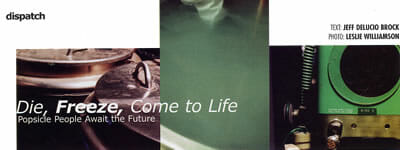WHEN YOU’RE A FROZEN corpse awaiting revival in the distant future, you never have to suffer disillusionment that Jerry Springer tops the daytime ratings. You never pull yourself from bed for the annoying late night shuffle to the bathroom. Presidents and fashions change – you don’t.
But as someone who wants to be turned to ashes with extreme heat, I can’t bear the thought of freezing my body after death in the hope that scientists will eventually cure what killed me and bring me back, as proposed by “cryonics” researchers. Is our society in such denial of death that we can’t just accept it with dignity? Still, I am a technophile, so I thought a trip to a company called Trans Time – “Life Extension Through Cryonic Suspension” – would convince me.
Trans Time is nestled innocuously in a light industrial section of San Leandro, California. President John Rodriguez answers the door in shorts and a T-shirt. An accountant by training, he’s a very genuine guy who acknowledges that this company may look a bit batty. “It just seems more practical to me that if you have the money, and you don’t have anything better to do after you’re dead, it might be an alright idea to take a chance that someday you’ll be revived,” Rodriguez says.
The Trans Time warehouse looks like the garage Dr. Frankenstein might have if he were a ’90s suburbanite with a Home Depot credit card. The walls are lined with a rainbow spectrum of trunks, milk crates filled with bottles of clear solution, clear drawers crammed with nuts and bolts, and slim oxygen containers. I realize – with some dread – that I am now sharing space with one living, breathing person and two individuals who are the exact opposite. But Rodriguez demurs: Although they are not conscious, “we really do think our patients are alive up there, and we’re just waiting to revive them.”
In addition to depending on science’s future ability to both cure the fatal maladies and revive the corpse, cryonicists also hope there will be a solution for all the pesky damage caused by the freezing process. Though highly secular, cryonics is itself a leap of faith. Rodriguez plans to get suspended, and U.S. attitudes that death is “God’s will” turn him cold. “It’s the same attitude as people saying, ‘If God wanted us to fly he would have given us wings,’ ” he says. “God had never written down anywhere that you shouldn’t be frozen.”
In 24 years of research, the technology hasn’t yet been proven in humans, although cryonicists can bring back human sperm and eggs, hamsters and dogs from as deep as -20º C (one such pooch is now the beloved pet of one of Trans Time’s advisors). One current research topic is “glassification,” which would avoid all the freezing damage. (I propose placing people in clear polyurethane, like the timelessly stylish rose in a paperweight or scorpion in a belt buckle.)
One woman with cancer volunteered to be frozen before death, but the California Supreme Court wouldn’t let her. The majority of people interested in Trans Time’s services are 32-year-old, white male computer programmers in Silicon Valley. That’s not a big leap; their muscles are already atrophied from endless hours in front of computer screens. Patients must cough up at least $120,000-150,000, usually through their life insurance policy. This is not some cryo-by-night operation – it’s well-funded and has invested wisely. But if the company tanks, the patients’ independent trusts will see to it that they’re transferred to another recommended facility. Rodriguez warns against choosing neophyte outfits that have just opened up. (Perhaps they skimp on the ice and just use salt curing.)
Rodriguez leads me around the warehouse to explain the freezing process, which can take up to two weeks. At the hospital, right when the doctor pronounces the patient dead, the eight-member Lazarus crew goes to work. After placing the body in a 10-foot metal sarcophagus, draining the blood, and replacing it with “blood extender,” they pack the whole body in ice and haul it back to home base. There they crack the chest open with a rotary saw and pump another solution into the main artery with a big heart/lung machine.
The body is then packed with dry ice into a Styrofoam box whose faux woodgrain could allow it to double as a lovely hope chest. A few days later the body is snuggled into a sleeping bag and gently placed in a six-foot-tall, semi-octagonal vertical canister. Beware, the whitened body does become brittle. In other words, You Break It, You Buy It.
After spending a week in a medium-size tank that slowly gets filled with liquid nitrogen, Trans Time’s nectar, the canister cools to the magic -194º C. In the last step, green-suited technicians pry the top off the 12-foot-tall mother tank, the canister’s final resting place. The aluminum lid hisses and crackles, and liquid nitrogen gas wafts over the top of the tank and fills a third of the warehouse, dropping the building’s mercury to almost freezing. A crane lifts the 600-pound canister+corpse package and submerges it head first. Six canisters can fit into the tank at once. (Another facility gets greater efficiency by compacting more people, but Trans Time graciously considers its customers’ comfort: “We don’t put them in like sardines.”) The staff must empty the tank for maintenance every 20 years, which I consider truly long-term planning, since there’s nothing I do “every 20 years.”
After vicariously completing the human popsicle’s journey, I walk back out into the late afternoon sunshine and decide my opinion hasn’t changed. I’ve often yearned to glimpse the future, but this ain’t for me. You see, my mom always uttered dire warnings not to play in the refrigerator, because you can’t open the door from the inside. And a life spent among frozen peas is no life at all.


